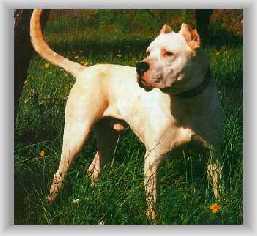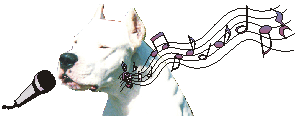

Hércules de
Bravura Blanca - Prop.: Francisco Castaño
Argentine Dogo's
Standard
Head:
Skull :
Solid, convex from back to front and transversely due to the
relief of the mastication muscles and the nape.
Face: Of
the same length as the skull. The distance from the stop to the
occiput is the same as the distance from the occiput to the
maxillary alveolus.
Jaws: Well-matched,
without prognathism, strong with large and well-placed teeth
(overshot and undershot bites are not permissible). Teeth are
strong, clean and free from cavities. The number of molars does
not matter while the most important thing is the homogeneity of
the dental arches, lack of cavities, no upper or lower
prognathism, and especially, that all four fangs, large and
clean, match perfectly while pressing to seize prey.
Eyes: Dark
or nut-brown. With black or flesh-colored eyelid rims, the
separation between them must be large, vivacious, smart look and
markedly stern at the same time.
Nose: Strongly
pigmented black color. Nostrils must be well-developed. The tip
of the nose is more elevated than the rest of the nose.
Ears: On
top of the head, erect or semi-erect, of triangular shape, must
always be cut. The judge must not judge a Dogo with long ears and
must remove it from the ring. Somewhat longer cut ears can be
accepted in females- like in Great Danes. The male is preferred
with slightly shorter ears. The Dogo Argentino is a prey dog,
that is, a fighting dog, and long ears can be easily grabbed and
very painful during fights. Moreover, aesthetical reasons make it
necessary to cut the ears.
Lips: Must
be well-turned-upward, stretched, with free rims and pigmented in
black.
Body:
Neck: Thick,
arched, well-built, with a very thick skin by the throat, forming
the wrinkles like those of the Mastiff, the Dogue de Bordeaux,
the Bulldog and not stretched, like in the Bull Terrier. Note:
Skin must be loose to permit it to slide over the body so that in
fighting the teeth and claws of the prey wound only the skin and
not the flesh. Flexibility of the skin over the throat permits
the Dogo to move rapidly to grab the prey.
Occiput:
Must not show any relief since it is completely concealed by the
powerful muscles of the nape, forming an arch-shaped linkage
between the head and the neck.
Chest:
Ample, deep, giving the sensation of having a large lung. When
seen from the front, the breastbone must overpass the elbows (
being the Argentine Dogo is a dog for work and for fight, it is
obvious the importance of an ample and deep chest due to the
importance of breathing for the dog).
Back:
Tall, very strong. With large muscular reliefs.
Thorax:
Ample: when seen sideways, its lower edge overpasses the elbows.
Spine:
Taller on the back, inclined toward the croup in a smooth slope.
In adult animals, when the development of back muscles and the
kidney is adequate, when seen sideways they show a median channel
along the spinal muscles.
Kidney:
Concealed by the muscles in the dorsum.
Legs:
Good muscles in the thighs, with short nails and tightly closed
toes, with no dewclaws. Must show good angulation, always having
in mind that they are the drivers for speed and the support for
close fighting so that the thigh muscle must always be
emphasized. The dewclaw, though very easy to get rid of during
the first few months, is a reason to deduct points by being a
recessive feature toward the Great Pyrenees, but is not a reason
for disqualification.
Tail:
Long and thick, held hanging naturally, but without overpassing
the hocks. It must be kept raised during the fight, with a
continuous lateral motion, like when fawning with the master. It
must be kept in mind that the tail is very helpful, whether
acting as a helm to change course during runs, as a compensatory
support during the fight acting in combination with the rear
quarters.
Height:
The minimum height for males is 62 centimeters and for females is
60 centimeters. The maximum is 67 centimeters at the shoulders.
This is so because it is understood that the Dogo must struggle
with bears, pumas, jaguars etc., and should be as big as possible
without falling into the giant category. Again, balance and
harmony should prevail.
Weight:
100-110 pounds.
Coat:
Short hair with no undercoat. It should be completely white.
Spots on the coat of any color are a disqualifier due to its
atavistic nature. White specimens with skin heavily pigmented in
black must be deemed as not good for breeding, due to the
recessive nature that it represents, which can turn predominant
in its descendants when mated with other specimens having this
latent defect. Small spot on the head is not a reason for
disqualification, however, between two similar specimens, the
completely white must be preferred. On the other hand, any spot
on the body is a reason for disqualification.
Disqualifications:
Blue or
china eyes
Deafness
Undershot/overshot
bite
Loose lips
hanging below lower jaw
Long hair
Height
under 60 centimeters
More that
one black patch on the head
Nose with
heavy pink pigmentation
Split
noses and harelips
